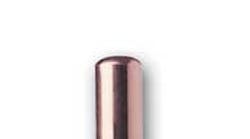MIG gun consumables comprise the front-end part of the gun — the nozzle, retaining head and contact tip — plus the liner. Together, these components are responsible for feeding the welding wire through the MIG gun and for establishing the electrical conductivity necessary to create the arc. These components are also among the most overlooked portions of the welding operation. Yet, without proper installation, storage and maintenance, these components can cause significant downtime for changeover and rework.
Fortunately, you can easily extend the life of these components and positively affect the efficiency and profit of your welding operation with a few basic tips.
Tip #1: Select, Store and Maintain Nozzles Properly
The nozzle is responsible for directing the shielding gas around the welding wire and arc to the weld puddle, and it protects the weld from the atmosphere or other contaminants. The nozzle is also a common place for spatter to accumulate and obstruct that shielding gas flow.
To prevent spatter build-up, select a nozzle with a smooth, non-porous surface that is free of sharp edges or flat surfaces, and store it in the plastic packaging in which it shipped. Unwrapping the nozzle and storing it in a bin causes dents and scratches on the surface of the nozzle on which spatter can accumulate. Visually inspect the inside and outside of the nozzle periodically for spatter, ideally several times throughout the welding shift. If it appears clogged, clean the nozzle using a tool specifically for the job or replace it if necessary.
You may want to use an anti-spatter compound (gels are commonly used in semi-automatic applications) to reduce the amount of spatter that adheres to the nozzle. Apply the compound by dipping the front inch and a half of the nozzle into the compound. Do not submerge the nozzle in the compound, as this can saturate the porous insulator inside the nozzle, causing it to fail prematurely. It can also cause the nozzle to accumulate spatter more readily and/or create an erratic arc.
Most semi-automatic MIG gun applications use slip-on nozzles. When installing one, securely connect the nozzle to the retaining head to prevent shielding gas leaks that could lead to poor weld quality. Also, be sure to handle the nozzle with clean hands or gloves. Debris, grease or oil from either can cause contaminants to enter the weld puddle or may cause premature failure of the component. Also, choose heavier, sturdier nozzles whenever possible. These may cost more up front, but they last longer and can prevent downtime for changeover that may cost you more money over the long term.
Finally, never use the nozzle to chip away at spatter. Doing so damages not only the MIG gun, but it also can dent or misshape the nozzle, rendering it unusable.
Tip #2: Keep Tight Connections
When possible, use a contact tip system (comprised of the contact tip and retaining head or diffuser) that stays tight or has locking features. The retaining head forms the connection between the nozzle and the MIG gun neck, holds the contact tip in place and also carries the electrical current to the contact tip to create an arc. If the connection between the retaining head and contact tip is not secure, electrical resistance can occur and cause the components to overheat and fail. Contact systems that allow the contact tip to be rotated to create a new wear surface are also good to use, as they can lengthen the life of the contact tip after key holing occurs. Key holing results when the bore in the contact tip erodes from the welding wire feeding through it.
Always store and handle the contact tip and retaining head properly. Keep them in their packages until you are ready to use them and be sure that they are free of oil or debris when you install them. Contaminants can cause electrical resistance, making the components overheat.
When installing a retaining head, tighten it according to the manufacturer's specifications, either by hand or by using a tool recommended for the job. It ensures a secure connection between the retaining head and the MIG gun neck and prevents shielding gas leaks and/or electrical resistance. When you install the contact tip, tighten the components securely using a pair of welding pliers. Do not use wire cutters, as these can cause scratches in the contact tip or misshape it, both problems that can shorten the tip's life and/or cause poor weld quality.
Inspect the contact tip regularly for spatter build-up and replace it as needed. Frequent inspections save time and money, if you consider the potential downtime for rework resulting from a damaged contact tip.
Most importantly, check that your contact tip and retaining head have not loosened during the course of welding. Tighten the components as needed to create a solid electrical connection. Remember, good conductivity results in better weld quality and helps the components last longer.
Tip #3: Liner Trim and Installation
A MIG gun liner spans the length from the front of the MIG gun through to the power pin and guides the welding wire through to the contact tip. It is usually composed of a steel coil, except when welding aluminum; these applications require a nylon liner or one of similar material.
As when choosing your contact tip, select the correct diameter liner for your welding wire to prevent wire feeding issues, arc wandering or other problems like bird nesting. Bird nesting occurs when the welding wire becomes tangled in the drive rolls and can also be caused by an improperly installed liner and/or by using the wrong drive roll tension.
Some manufacturers offer liners that load from the front of the MIG gun. Using this style can save you time for liner replacement and may help you avoid some of the pitfalls common to replacing a standard, full-length liner.
Whichever liner style you choose, be sure to keep it from dragging on the floor during installation. Instead wrap it in a coil in one hand as you feed it into the MIG gun, and make certain that your hands or gloves are clean during the process. This keeps debris from entering the liner and causing blockages that could lead to feeding problems and/or welding wire damage.
How often you change your MIG gun liner will depend largely on your welding application, the type of welding wire you use, the length of time you weld and at what amperage. Track the length of time from one installation to another, using that timeframe as a guideline for how long your liner typically lasts. Some welding operators also blow compressed air through the liner periodically to extend the component's life.
You can further lengthen the life of your liner by using the shortest MIG gun cable length possible for your welding application. This precaution helps prevent kinking and minimizes the chance of poor wire feeding that could lead to costly downtime. Be certain also to keep the cable clear of any equipment, such as a forklift, that could damage it.














